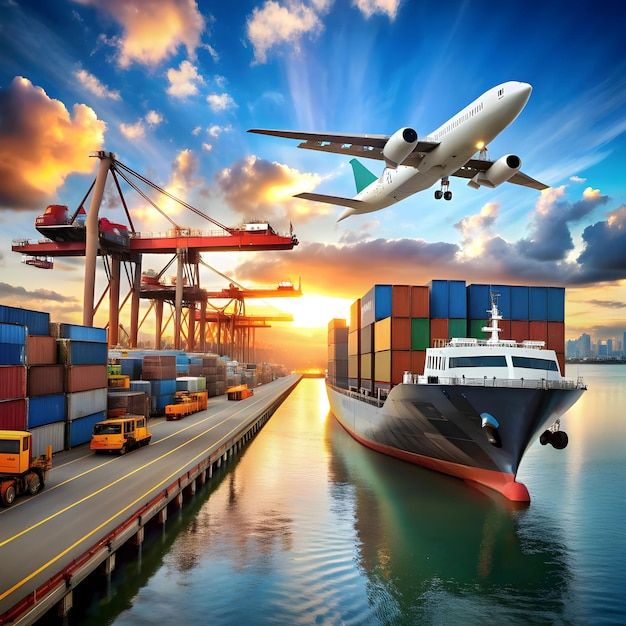- By Della tj
- November 3, 2025
- Sea Freight, Shipping
When global demand rises, businesses seek fast sea freight from Shenzhen to USA to balance cost, reliability, and transit time. Shenzhen’s strategic port infrastructure allows exporters to ship efficiently while minimizing customs delays. This guide explores cost-effective methods, shipping schedules, customs procedures, and real-world case studies showing how sea freight ensures on-time delivery across the Pacific.

1. Why Choose Fast Sea Freight from Shenzhen to USA
Although air freight is faster, sea freight offers the best balance between cost, capacity, and stability. Shenzhen connects directly with major U.S. ports such as Los Angeles, Long Beach, and Houston. Moreover, frequent vessel schedules guarantee steady supply chains for electronics, machinery, furniture, and apparel.
| Comparison | Sea Freight | Air Freight |
|---|---|---|
| Average Transit Time | 14–22 days | 3–7 days |
| Cost (per kg) | $0.3–$0.8 | $5–$8 |
| Ideal for | Bulk, pallets, containers | Urgent small parcels |
| Carbon Emission | Low | High |
As a result, importers prefer sea freight for bulk shipments where cost-efficiency outweighs ultra-fast delivery. Additionally, reliable shipping lines now offer express FCL services that cut ocean transit time by up to 30%.

2. Understanding Shipping Options: FCL vs LCL
Exporters can choose between Full Container Load (FCL) and Less than Container Load (LCL) options depending on cargo volume.
- FCL (Full Container Load): Ideal for shipments over 15 CBM or 10 tons. Entire container reserved, offering security and predictable schedules.
- LCL (Less than Container Load): For smaller cargo; shared space lowers cost but may involve additional handling and slightly longer delivery.
| Container Type | Dimensions | Capacity | Common Use | Approx. Cost (Shenzhen–LA) |
|---|---|---|---|---|
| 20 ft FCL | 6 × 2.4 × 2.6 m | 28 CBM / 28 tons | Light machinery | $1,200–$1,600 |
| 40 ft FCL | 12 × 2.4 × 2.6 m | 58 CBM / 28 tons | Furniture / electronics | $2,000–$2,500 |
| LCL | – | <15 CBM | Small mixed goods | $45–$75 per CBM |
Although FCL may seem more expensive, it reduces risk, and, in many cases, fast sea freight consolidations use priority vessels with fewer transshipments.

3. Estimated Transit Time and Major Routes
Transit times vary by destination and shipping line. Direct sailings from Shenzhen to U.S. West Coast ports average 14–18 days, while East Coast routes require 25–30 days.
| Route | Transit Time (days) | Port of Arrival | Remarks |
|---|---|---|---|
| Shenzhen → Los Angeles | 14–16 | Long Beach Terminal | Fastest direct route |
| Shenzhen → Seattle | 16–18 | T-18 Port | Stable schedule |
| Shenzhen → Houston | 25–28 | Bayport Terminal | Panama Canal route |
| Shenzhen → New York | 28–30 | Newark Port | Trans-Panama route |
Moreover, some express services combine sea + rail via the U.S. West Coast, cutting total delivery to 12 days for inland states like Texas or Illinois.
Ready to streamline your shipping? Contact us today for a fast, Partner with TopChinaFreight to receive a tailored logistics solution that matches your shipping needs.
4. Customs Clearance and Documentation
Efficient documentation is vital to maintaining fast sea freight from Shenzhen to USA. Incomplete paperwork can delay clearance for days or even weeks.
Essential Documents Checklist
| Document | Description | Issued By |
|---|---|---|
| Bill of Lading (B/L) | Proof of shipment | Shipping line |
| Commercial Invoice | Declares value and goods | Exporter |
| Packing List | Itemized content breakdown | Shipper |
| Certificate of Origin | Confirms manufacturing country | CCPIT China |
| ISF Filing (10+2) | Mandatory for U.S. imports | Importer/Agent |
| Arrival Notice | Customs clearance alert | Forwarder |
Additionally, U.S. Customs and Border Protection (CBP) may request inspection for high-value or restricted goods. Therefore, working with an experienced freight forwarder in Shenzhen ensures pre-clearance and reduces port storage costs.

5. Cost Structure and How to Save Money
Shipping costs fluctuate based on container size, route, fuel surcharge, port handling, and seasonal demand. The following table summarizes average rates:
| Cost Component | 20 ft FCL | 40 ft FCL | LCL (per CBM) |
|---|---|---|---|
| Ocean Freight | $1,200 | $2,200 | $55 |
| Origin Charges | $120 | $150 | $20 |
| Destination Charges | $300 | $350 | $35 |
| Customs + ISF Fee | $90 | $90 | $90 |
| Total Est. Cost | $1,710 | $2,790 | $200 (min) |
Tips to save money:
- Book early to secure lower rates.
- Choose direct routes to avoid transshipment fees.
- Combine shipments under a single B/L.
- Optimize packaging to maximize CBM utilization.
Furthermore, negotiating annual contracts with carriers can stabilize rates during high seasons.
6. Real-World Case Studies
Case 1: Electronics Shipment – Shenzhen to Los Angeles
Cargo: Smart Home Devices
Volume: 40 ft FCL (58 CBM)
Transit Time: 15 days
Freight Cost: $2,300
Route: Shekou → Long Beach
Outcome: Delivered two days ahead of schedule using express vessel service.
Case 2: Furniture Shipment – Shenzhen to New York
Cargo: Wooden furniture sets
Volume: 20 ft FCL (28 CBM)
Transit Time: 29 days via Panama Canal
Freight Cost: $1,750
Outcome: Smooth customs clearance after ISF pre-filing by forwarder.
7. How to Select the Right Freight Forwarder
Selecting a professional forwarder determines delivery speed and cost efficiency. Look for companies offering end-to-end services including:
- Cargo pickup and packing
- Booking and customs documentation
- U.S. customs clearance support
- Real-time tracking and insurance
Moreover, verify whether the forwarder has FMC (USA) registration and NVOCC status. Such licenses ensure compliance and access to discounted carrier rates.
| Evaluation Criteria | Description | Why It Matters |
|---|---|---|
| Experience | 5+ years handling US routes | Avoids delay and miscommunication |
| Network | Partnerships with major carriers | Ensures stable schedules |
| Transparency | Clear rate breakdown | Prevents hidden charges |
| Customer Support | 24/7 tracking assistance | Improves visibility |
Ultimately, a trusted forwarder simplifies complex shipping procedures and guarantees timely arrival.
8. Key Trends and Future Outlook
The rise of e-commerce and omnichannel distribution has reshaped demand for fast sea freight from Shenzhen to USA. New megaships, automated ports, and digital tracking systems accelerate ocean logistics. Meanwhile, green initiatives drive the adoption of LNG-powered vessels to cut emissions by 25%.
Furthermore, AI-based forecasting helps shippers adjust to seasonal peaks and avoid container shortages. Therefore, importers who adopt data-driven planning gain an edge in cost control and delivery accuracy.
Conclusion
To summarize, fast sea freight from Shenzhen to USA delivers a cost-efficient and reliable solution for exporters and importers alike. By choosing direct routes, preparing accurate documentation, and partnering with experienced forwarders, businesses can achieve on-time delivery without overspending. Ultimately, sea freight remains the backbone of China-U.S. trade and continues to evolve toward greater speed and efficiency.
Request a Quote
Need a tailored solution for your shipping from China?
Let TJ China Freight Forwarder assist you with reliable, cost-effective service.
FAQ:
Q1.How long does sea freight from Shenzhen to USA usually take?
Typically 14–18 days to West Coast ports and 25–30 days to East Coast, depending on route and carrier.
Q2.What is the cheapest shipping method from Shenzhen to USA?
LCL sea freight is the most affordable for small volumes, especially when using shared containers and direct routes.
Q3.Do I need an import license for sea freight shipments?
Most U.S. importers must have an IRS or EIN number for customs filing and ISF submission before departure.
Q4.Can I track my sea freight in real time?
Yes, major forwarders offer online tracking platforms with container numbers and automatic status updates.
Q5.Which documents are essential for customs clearance?
Bill of Lading, commercial invoice, packing list, and ISF filing are mandatory for all U.S. bound cargo.
